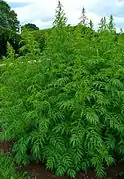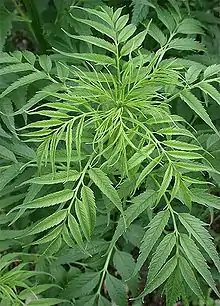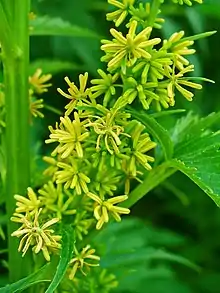Datisca cannabina
Datisca cannabina, called false hemp, is a species of flowering plant in the genus Datisca, family Datiscaceae, native to the Aegean Islands, Crete, Cyprus, Anatolia, the Levant, the Transcaucasus, Iraq, Iran, Central Asia, Afghanistan, Pakistan, the western Himalayas and Nepal.[2] It is one of the very few species known to have true androdioecy, meaning it has a mix of male and hermaphroditic individuals.[3] Local artisans use its roots to produce a fast yellow dye.[4]
 Growth form
Growth form
 In fruit
In fruit Seeds
Seeds
| Datisca cannabina | |
|---|---|
 | |
| Male flowers | |
| Scientific classification | |
| Kingdom: | Plantae |
| Clade: | Tracheophytes |
| Clade: | Angiosperms |
| Clade: | Eudicots |
| Clade: | Rosids |
| Order: | Cucurbitales |
| Family: | Datiscaceae |
| Genus: | Datisca |
| Species: | D. cannabina |
| Binomial name | |
| Datisca cannabina | |
| Synonyms[2] | |
|
List
| |
References
- Sp. Pl.: 1037 (1753)
- "Datisca cannabina L." Plants of the World Online. Board of Trustees of the Royal Botanic Gardens, Kew. 2017. Retrieved 12 December 2020.
- Wolf, Diana E.; Rieseberg, Loren H.; Spencer, Stanley C. (1997). "The genetic mechanism of sex determination in the androdioecious flowering plant, Datisca glomerata (Datiscaceae)". Heredity. 78 (2): 190–204. doi:10.1038/hdy.1997.27. S2CID 27605267.
- Liotard, L. (1881). Memorandum on Dyes of Indian Growth and Production. Calcutta: Home Revenue and Agricultural Department Press. p. 89–96.
…roots of alkabir (Datisca cannabina)…
This article is issued from Wikipedia. The text is licensed under Creative Commons - Attribution - Sharealike. Additional terms may apply for the media files.